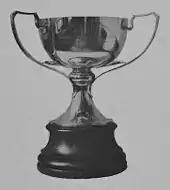Copa Ibarguren
The Copa Dr. Carlos Ibarguren, also called Campeonato Argentino[1] or simply Copa Ibarguren was an official Argentine football cup competition contested between 1913 and 1958. Between 1913 and 1925, the winner of the cup received the honor to be the "Argentine Champion". That is because the cup faced the two strongest champions of the country, represented by the Buenos Aires league (Primera División) and the Rosario league (with its affiliated teams competing in Copa Nicasio Vila, the main division of LRF).
 The trophy awarded to champions | |
| Organising body | AFA |
|---|---|
| Founded | 1913 |
| Abolished | 1958 |
| Region | Argentina |
| Number of teams | 2 |
| Related competitions | Primera División Regional leagues |
| Last champions | Liga Cordobesa (1958) |
| Most successful club(s) | Racing Boca Juniors (5 titles each) |
History
The trophy was donated by the Argentine Minister of Public Instruction Dr. Carlos Ibarguren to be played between the champions of all of the regional leagues in Argentina. The cup was only ever contested as a one off game between:
- 1913–1938: Primera División vs Liga Rosarina
- 1939: Primera División vs Litoral league
- 1940–1941: Primera División vs Liga Rosarina
- 1942–1958: Primera División vs Copa Presidente
List of champions
Finals
The following list includes all the editions of the Copa Ibarguren:[2]
.jpg.webp)

Titles by team

| Team | Titles | Years won |
|---|---|---|
| Racing | 5 | 1913, 1914, 1916, 1917, 1918 |
| Boca Juniors | 5 | 1919, 1923, 1924, 1940, 1944 |
| River Plate | 4 | 1937, 1941, 1942, 1952 |
| Huracán | 2 | 1922, 1925 |
| Independiente | 2 | 1938, 1939 |
| Rosario Central | 1 | 1915 |
| Tiro Federal | 1 | 1920 |
| Newell's Old Boys | 1 | 1921 |
| Liga Cordobesa [note 8] | 1 | 1958 |
Notes
- Only in case the final ended in a tie
- Estudiantes de Buenos Aires had its field in Palermo, Buenos Aires
- Estadio "Crucecita"
- The first match (won by Boca Juniors) was annulled because it had fielded ineligible players. Therefore a second game was held, being won by Tiro Federal.
- Located on Humboldt and Padilla, in Villa Crespo
- This editon was official although AFA has not included this edition on its list of national cup winners.[3]
- The team from Córdoba Football League defeated Racing by 4–3 [5] but AFA does not mention the Regional representative as champion on its website. Moreover, AFA does not even cite the tournament.[3]
References
| Wikimedia Commons has media related to Copa Ibarguren. |
- Argentina - Copa Ibarguren by Osvaldo Gorgazzi on the RSSSF
- Argentina Domestic Cups history - RSSSF
- Copas Nacionales on AFA website, retrieved 29 Dec 2020
- Copa Ibarguren 1952
- Copa Ibarguren 1958